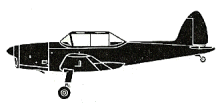
ASN Wikibase Occurrence # 20417
This information is added by users of ASN. Neither ASN nor the Flight Safety Foundation are responsible for the completeness or correctness of this information.
If you feel this information is incomplete or incorrect, you can submit corrected information.
| Date: | Tuesday 27 March 1951 |
| Time: | day |
| Type: |  de Havilland Canada DHC-1 Chipmunk T.10 |
| Owner/operator: | 11 RFS RAF |
| Registration: | WB737 |
| MSN: | C1/0186 |
| Fatalities: | Fatalities: 1 / Occupants: 2 |
| Aircraft damage: | Destroyed |
| Location: | River Tay, near Kingoodie, Angus -
 United Kingdom United Kingdom
|
| Phase: | Manoeuvring (airshow, firefighting, ag.ops.) |
| Nature: | Military |
| Departure airport: | Perth Airfield, Scotland (PSL/EGPT) |
| Confidence Rating: |
de Havilland Canada DHC-1 Chipmunk T.10 WB737, 11 RFS (Reserve Flying School): Written off (destroyed) 27/3/1951. The aircraft was seen to enter a spin from what seemed to be an adequate altitude, with enough height to initiate a safe spin recovery. However, no recovery was made from the spin, and the aircraft struck the waters of the River Tay, near Kingoodie, Angus.
Why the pilot did not recover from the spin was never established by the RAF Board of Inquiry: it is possible that the pilot may have allowed the spin to continue for too long before starting recovery action, and the flatter spin characteristics on this occasion may have led him to take the incorrect and inappropriate recovery action. Of the two person on board, the pilot was killed, and the occupant of the rear seat survived with injuries
Crew of Chipmunk WB737:
Sergeant William MacKay RAF (pilot) - killed on active service 27/3/1951
Sergeant R L Robinson RAF (rear seat passenger) - survived with injuries
Wreckage recovered by (and to) 63 MU RAF Edzell, where scrapped after completion of accident investigation procedures. The crash location was into the River Tay near Kingoodie, a hamlet about 4 miles (6.4 km) south west of Dundee, but in the region of Perth and Kinross, Scotland at approximate co ordinates 56.451840°N 3.074401°W
Sources:
1. Halley, James (1999) Broken Wings – Post-War Royal Air Force Accidents Tunbridge Wells: Air-Britain (Historians) Ltd. p.112 ISBN 0-85130-290-4.
2. Royal Air Force Aircraft SA100-VZ999 (James J Halley, Air Britain, 1983)
3. Last Take Off; A Catalogue of RAF Aircraft Losses 1950 to 1953 by Colin Cummings p.125
4. http://www.ukserials.com/results.php?serial=WB
5. https://en.wikipedia.org/wiki/Kingoodie
Revision history:
| Date/time | Contributor | Updates |
|---|---|---|
| 01-Jun-2008 17:48 | JINX | Added |
| 07-Jun-2008 22:00 | JINX | Updated |
| 12-Nov-2011 08:22 | Dr. John Smith | Updated [Location, Phase, Departure airport, Source, Narrative] |
| 15-May-2013 13:23 | Nepa | Updated [Operator] |
| 16-Jan-2021 17:15 | Dr. John Smith | Updated [Time, Total occupants, Source, Narrative] |
| 16-Jan-2021 17:16 | Dr. John Smith | Updated [Narrative] |
Corrections or additions? ... Edit this accident description
The Aviation Safety Network is an exclusive service provided by:


 ©2024 Flight Safety Foundation
©2024 Flight Safety Foundation